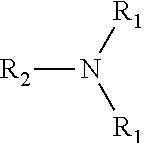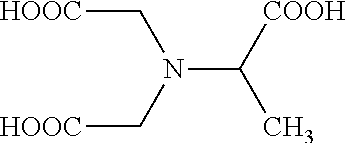Phosphorus free low temperature ware wash detergent for reducing scale build-up
a low temperature, detergent technology, applied in the direction of detergent compounding agents, inorganic non-surface active detergent compositions, cleaning using liquids, etc., can solve the problems of heavy scale formation that is difficult to control, the hardness level in water can have a deleterious effect in many systems, and affect the aesthetic appearance of ware, etc., to achieve the effect of reducing hard water scal
- Summary
- Abstract
- Description
- Claims
- Application Information
AI Technical Summary
Benefits of technology
Problems solved by technology
Method used
Image
Examples
embodiments
[0092]Exemplary ranges of the concentrated phosphorus-free detergent compositions according to the invention are shown in Table 1 in weight percentage of the liquid detergent compositions. Sanitizers that are employed with the concentrated phosphorus-free detergent compositions according to the invention for use at low temperatures may be formulated into the composition or provided separately from the detergent compositions. In a further aspect, rinse aids may be further employed with the concentrated phosphorus-free detergent compositions, which may be formulated into the composition or provided separately from the detergent compositions. In a preferred aspect, the use of rinse aids and / or sanitizers are provided separately from the detergent compositions.
TABLE 1FirstSecondThirdFourthExemplaryExemplaryExemplaryExemplaryMaterialRange wt-%Range wt-%Range wt-%Range wt-%Water20-8030-8030-6045-55Amino-0.1-15 1-101-52-5carboxylateAlkalinity20-8030-8040-7040-60SourceWater0.1-150.1-10 1-...
example 1
[0114]A liquid detergent composition according to the invention was compared to a control composition containing phosphorus as shown below in Table 2. The experimental formula (EXP1) according to the invention was calculated to have the same percent actives water conditioning polymer (Acumer 1000) as the Control formula at the time of the experiment.
TABLE 2DescriptionControlEXP1Softened Water20-8020-80Trilon M (40%)02.5-5 Bayhibit AM (50%)1-50Sodium Hydroxide (50%)25-6025-60Acumer 1000 (48%)0.1-5 0.1-5
[0115]Beneficially, the replacement of the Bayhibit AM from the Control with the Trilon M in the EXP1 formulation results in a phosphorus-free, liquid detergent composition.
example 2
[0116]The experimental formula (EXP1) and Control according to Example 1 were further evaluated to determine the impact of removal of phosphorus from the formulation on the cleaning efficacy and threshold effect with regard to scale build-up. A 100 cycle glass cleaning experiment was performed using six 10 oz. Libby glasses and a Cambro Newport plastic tumbler on a ES-2000 ware wash machine employing 17 grain water (hard water source). Initially the glasses were prepared using a cleaning cycle to completely remove all film and foreign material from the glass surface.
[0117]The ware wash machine controller was set to automatically dispense the indicated amount of detergent into the wash tank. Six clean glasses (G=glass tumblers) and a clean plastic tumbler (P=plastic tumbler) were placed in a Raburn rack (see figure below for arrangement) and the rack was placed inside the dishmachine.
GGGGGPG
[0118]The ware wash machine automatically dispensed into the ware wash machine the detergent c...
PUM
| Property | Measurement | Unit |
|---|---|---|
| temperatures | aaaaa | aaaaa |
| temperature | aaaaa | aaaaa |
| temperature | aaaaa | aaaaa |
Abstract
Description
Claims
Application Information
 Login to View More
Login to View More - R&D
- Intellectual Property
- Life Sciences
- Materials
- Tech Scout
- Unparalleled Data Quality
- Higher Quality Content
- 60% Fewer Hallucinations
Browse by: Latest US Patents, China's latest patents, Technical Efficacy Thesaurus, Application Domain, Technology Topic, Popular Technical Reports.
© 2025 PatSnap. All rights reserved.Legal|Privacy policy|Modern Slavery Act Transparency Statement|Sitemap|About US| Contact US: help@patsnap.com


